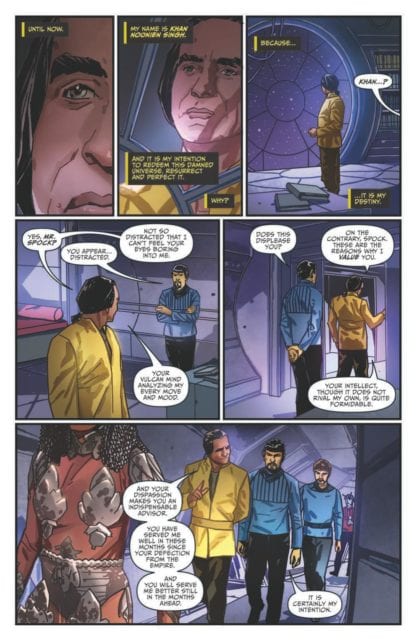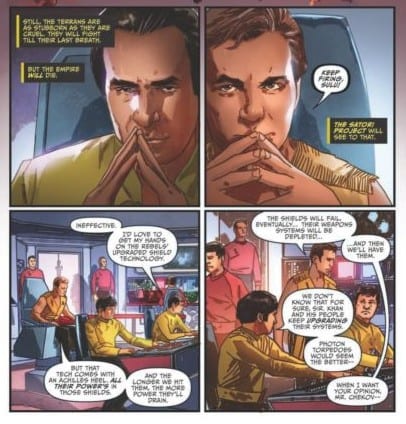The Mirror Universe, Star Trek’s parallel dimension, is as much as a part of the geek zeitgeist as the series itself. Over the years each series has ventured into the alternative universe which first appeared in The Original Series episode Mirror, Mirror in 1967. The concept of an ‘evil’ dimension where the regular cast have become compromised by disturbing philosophies is a popular narrative featured in a number of different T.V. Shows. Series such as Doctor Who and Buffy The Vampire Slayer have both used the trope and the comedy show Community made it an ongoing part of their second and third seasons.
In Star Trek, the Mirror Universe has touched almost every aspect of the franchise. The first series of Star Trek: Discovery used crossing over a major part of the plot, and a number of comic writers and artists have also played in the sandbox of black leather and goatee beards.
The latest one shot from IDW Publishing, Star Trek Hell’s Mirror, features the regular cast of the original series as seen in the first crossover story. It also includes possibly one of the franchise’s most popular villains: Khan Noonien Singh.
MFR ON YOUTUBE (latest video)
Help us reach 5K Subs!

Crossing Over
J.M. DeMatteis will be a recognisable name to comic book readers. He has an impressive history writing for Marvel and DC as well as a slate of comics for smaller publishers. He also wrote the final issue of Marvel’s original Star Trek comic, published in 1982, so his return to the franchise is an exciting one.
The story is simple: DeMatteis reintroduces Khan to the reader through an opening monologue, although some prior knowledge of the character and the Mirror Universe at large is required. Going into this blind will leave you stumbling in the dark for a while, trying to reconcile the characters with what you already know about them. Having said that, the chances that this comic is picked up by anyone who isn’t already closely familiar with Star Trek history is very slim.
After the reintroduction, Khan’s journey takes him across the Terran Empire, inciting rebellion and behaving as you might expect, except there is a twist. In this universe Khan is the hero, a seeker of peace and freedom for all. DeMatteis tells the story from Khan’s point of view allowing the reader to get close to the character, with the regular Star Trek cast playing second fiddle.
DeMatteis picks out elements of the original Mirror, Mirror episode and the second Star Trek movie, recreating them in the story with a subtle twist. This roots the narrative in a world the reader will recognise but also highlights the difference between the Federation and the Terran Empire. It is clear from the narration by Khan and the actions on the page that this is a universe fuelled by hatred and anger.

Mirror Image
Artist, Matthew Dow Smith, renders the characters with thin, black lines, focusing on outlines while the detail is filled in by colorist Candice Han. This is a very effective style for the comic and adds depth to the page. The shading allows for a realistic image and brings out the emotion of the characters.
Han’s coloring also makes the characters easy to follow on the page. Each of the main cast has a slightly different uniform with a varying degree of brightness. This is important because some of the panels are laden with speech balloons covering up so much of the image. This is not a fault of the lettering by Neil Uyetake but a problem with an over-written script. The text on the page needed to be edited or the panel layouts should have been altered. On a number of pages, the text heavy script is not a problem, the opening of the comic is testament to this, but other pages are weighed down by exposition and flocks of speech balloons.
This is a shame because the artwork itself is wonderful. Smith draws an astonishing background that sets the scene perfectly. At no point throughout the comic are you in any doubt that this is an alternative universe or the form this dystopian world takes. The atmosphere on each page is as oppressive as the Terran Empire itself with the characters fighting their way through their lives. Smith also places panels side by side to create exciting comparisons between characters and situations. This is most notable when comparing the two leads, Kirk and Khan.
Smith uses a very standard set of viewpoints for the reader to see the action. This mix of long shot to body shot to close up relates to the era that the Original Star Trek hails from. The look of the series and the spin off movies is captured by Smith who only employs low or high angles to emphasise a major moment in the story.

Conclusion
The purpose of an alternate universe is to illustrate something about the central characters of the story. By portraying an ‘evil’, emotional Spock, it gives the audience a greater insight into the Spock we already know. Hell’s Mirror fails to do this, instead relies on the simple premise of the characters being opposite versions of themselves. The character of Khan isn’t grown by his appearance here because there is no comparison between the original and the doppelganger. We are given a fully realised character but not shown how he relates to the character we already know.
The assumption made in this comic is that because everyone else is playing against type, then Khan would do so as well. The main aim of Hell’s Mirror seems to be to retell The Wrath of Khan with the central roles reversed: Kirk is the aggressor and Khan the diplomat. This makes for a fun read, and this comic is a mountain of fun, but it feels like a missed opportunity. There was the chance here to delve into the mirror universe and create a unique take on the characters, giving the readers something truly unexpected. Unfortunately, this just isn’t the case and Hell’s Mirror is nothing more than a single idea stretched to fill 24 pages of comic.
Khan is a fascinating and fantastic character and deserves more page/screen time but there are much better stories out there with him in. This isn’t a bad rendition of the character, not like the Benedict Cumberbatch take in the movie Into Darkness, but the concept does have a greater potential than is present in Hell’s Mirror.

